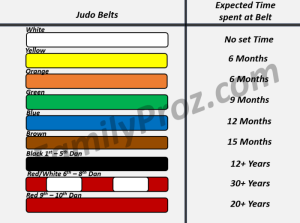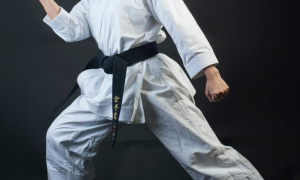The Judo belt system holds a fascinating history, originating in 1907 under the guidance of Jigoro Kano, the founder of Judo. In its early days, practitioners were distinguished by just two belt colors: white, representing beginners learning the fundamentals, and black, symbolizing advanced students who had mastered the basics and were ready to pursue Judo at a higher level.
The black belt remains the pinnacle of achievement in Judo. Attaining a black belt, known as a 1st Dan, is a significant milestone, but the journey doesn’t end there. Judo recognizes the expertise of practitioners through Dan ranks, ranging from 1st to 10th Dan. Beyond 5th Dan, a white and red belt is used, while practitioners with a 9th or 10th Dan wear a red belt.
Over time, Judo’s belt system has influenced various martial arts, such as Brazilian Jiu-Jitsu, where the gi and belt remain as a reminder of its roots.
Table of Contents
Toggle![]()
What is the order of belts in Judo?

A common order belt order used by Judo schools worldwide is:
- White Belt (6th Kyu)
- Yellow Belt (5th Kyu)
- Orange Belt (4th Kyu)
- Green Belt (3rd Kyu)
- Blue Belt (2nd Kyu)
- Brown Belt (1st Kyu)
- Black Belt (1st Dan)
Beyond the first-degree black belt, practitioners can progress through higher Dan ranks, with 10th Dan being the highest. The Red belt with additional white markings is used for Dan ranks beyond 5th Dan, and the red belt is reserved for those with 9th and 10th Dan ranks.
![]()
How long does each Judo Belt take to achieve?
The time it takes to achieve each Judo belt can vary based on the individual’s dedication, training frequency, and the specific requirements of the relevant organization or school. Below is a table showing a general guideline for the time it may take to achieve each rank:
|
Level |
Judo Belt |
Avg. Time to Advance |
Estimated Total Time |
| 6th Kyu | White Belt | No set time | No set time |
| 5th Kyu | Yellow Belt | 6 months as White Belt | 6 Months |
| 4th Kyu | Orange Belt | 6 months as Yellow Belt | 1 year |
| 3rd Kyu | Green Belt | 9 months as Orange Belt | 2 ¼ years |
| 2nd Kyu | Blue Belt | 12 months as Green Belt | 3 ¼ years |
| 1st Kyu | Brown Belt | 12 months as Blue Belt | 4 ¼ years |
| Black Belt | Black Belt | 15 months as Brown Belt | 5 ½ years |
![]()
What does each Judo rank mean?
Judo White Belt (6th Kyu)
![]()
- The White Belt is the first Belt (6th Kyu) and only requires a few lessons to attain. It serves as an introduction into the Judo Belt system.
The white belt is the starting point for all Judo practitioners, symbolizing purity and humility. It represents a blank canvas, signifying the beginning of the Judo journey. At this stage, students learn fundamental techniques and develop a strong foundation for their future growth in the art.
![]()
Judo Yellow Belt (5th Kyu)
![]()
- The Yellow Belt is the second Belt (5th Kyu). On average the yellow belt can be achieved after 6 months of training.
Advancing from the white belt, the yellow belt represents progress and a deeper understanding of Judo techniques. Students at this level begin to refine their basics and gain more confidence in applying them during practice. The yellow belt symbolizes the initial stages of a judoka’s growth and development.
![]()
Judo Orange Belt (4th Kyu)
![]()
- The Orange Belt is the third Belt (4th Kyu). On average the orange can be achieved after 12 months of training
As judokas continue to improve their skills and knowledge, they attain the orange belt. This belt represents further growth and proficiency in Judo techniques. At this stage, practitioners start to develop their style and become more adaptable to different scenarios on the mat.
![]()
Judo Green Belt (3rd Kyu)
![]()
- The Green Belt is the fourth (3rd Kyu). On average the green belt can be achieved after 2 years of training
The green belt signifies substantial progress in Judo, reflecting a higher level of proficiency. At this stage, students have become more experienced and confident in executing a wide range of techniques effectively. The green belt represents the blossoming of skills and the continued dedication to the art.
![]()
Judo Blue Belt (2nd Kyu)
![]()
- The Blue Belt is the fifth Belt (2nd Kyu). On average the blue belt can be achieved after 3 years of training
The blue belt is an important milestone, indicating an intermediate level of proficiency. At this stage, judokas have honed their techniques to a higher degree of precision. The blue belt symbolizes the practitioner’s growing competence and understanding of the intricacies of Judo.
![]()
Judo Brown Belt (1st Kyu)
![]()
- The Brown Belt is the sixth Belt (1st Kyu). On average the brown belt can be achieved after 4 years of training.
The brown belt is the last Kyu rank before reaching the highly respected black belt level. It represents advanced proficiency and a commitment to excellence in Judo. At this stage, practitioners demonstrate a deep understanding of the art and are well-prepared to embark on their journey towards the black belt.
![]()
Black Belt (1st Dan)
![]()
- The Black Belt is the seventh Judo Belt (1st Dan). On average the black belt can be achieved after 5 years of training.
The judo black belt is one of highest belts in Judo and a significant accomplishment for any practitioner. Achieving the black belt status indicates mastery of the fundamentals and signifies readiness to pursue Judo at an even more serious and advanced level. It is a testament to the dedication, hard work, and years of training put into the art.
![]()
Learn about other Martial Arts Belt systems in our articles on the:
![]()
Judo Black Belt ranks (Dans)
The Judo black belt ranks, known as “Dans,” consist of a total of 10 levels. The time it takes to achieve each Dan rank can vary between different Judo organizations and schools, as they set their own criteria and requirements for promotion. Active participation in Judo competitions and successful achievements can expedite the progression through the Dan ranks, as it reflects a judoka’s practical application and proficiency in the art.
Notably, the 9th and 10th Dan black belts are generally given on an honorary basis, considering the individual’s profound impact in spreading and promoting Judo, rather than solely based on technical skill. Holders of these ranks have demonstrated outstanding leadership, significant contributions, and dedication to the advancement of Judo, making them respected figures and mentors in the Judo community.
The table below shows an estimation of time taken to achieve each Judo Dan.
| Rank (Dan) | Time to Advance |
| Shodan (1st Dan) | 2-3years |
| Nidan (2nd Dan) | 3-4 years |
| Sandan (3rd Dan) | 4-5 years |
| Yodan (4th Dan) | 5-6 years |
| Godan (5th Dan) | 6-7 years |
| Rokudan (6th Dan) | 10-12 years |
| Shichidan (7th Dan) | 12–14 years |
| Hachidan (8th Dan) | 15–20 years |
| Kudan (9th Dan) | No set Time |
| Judan (10th Dan) | No set Time |
Higher Dan Ranks and the Red Belt:
Beyond the first-degree black belt, judokas can progress through higher Dan ranks, each representing a higher level of expertise and understanding. Dan ranks beyond 5th Dan are often denoted by red belts with additional white markings. The prestigious red belt is reserved for those who have reached 9th or 10th Dan, representing an elite level of mastery and knowledge in Judo.
Each rank in the Judo system is a stepping stone on the path of continuous improvement and learning. Progressing through these ranks not only demonstrates technical proficiency but also embodies the values of discipline, respect, and perseverance, which lie at the heart of the martial art. As practitioners climb the ladder of belts, they gain a deeper appreciation for the art of Judo and its profound impact on both their physical and mental development.
![]()
What is the highest belt in Judo?
![]()
The highest belt in Judo is the red belt, which is also known as the 9th or 10th Dan black belt. Achieving this rank is a testament to a practitioner’s unparalleled mastery, knowledge, and lifelong dedication to the art of Judo. Red belt holders are considered living legends within the Judo community, having made significant contributions to the development and advancement of the martial art.
![]()
How many years does it take to master Judo?
There is no fixed timeline for mastering Judo as it is a lifelong journey of continuous learning and improvement. However, it’s generally accepted that achieving a high level of proficiency in Judo, such as earning a black belt, can take anywhere between 4-6 years of dedicated training.
How long does it take to achieve a Judo Black Belt?
On average, it takes anywhere from 4 to 6+ years to achieve a Judo black belt. Some practitioners may attain their black belt in a relatively short period, especially if they train intensively and consistently. Others may take longer due to personal commitments, differences in learning speed, or pursuing Judo as a part-time activity. It’s essential to remember that the journey to a black belt is as important as the destination.
![]()
What is a red and white belt in Judo?
![]()
In Judo, a red and white belt is a distinctive belt worn by practitioners who have achieved the rank of 6th to 8th Dan. The red and white belt is a prestigious symbol of advanced expertise and dedication to the art of Judo.
As practitioners progress beyond the initial black belt (1st Dan), they are awarded higher Dan ranks as they continue to develop their skills and understanding of Judo. The progression from 1st Dan to 5th Dan is typically denoted by solid black belts. However, starting from 6th Dan, a red and white belt is used to signify the increased level of mastery and experience of the judoka.



